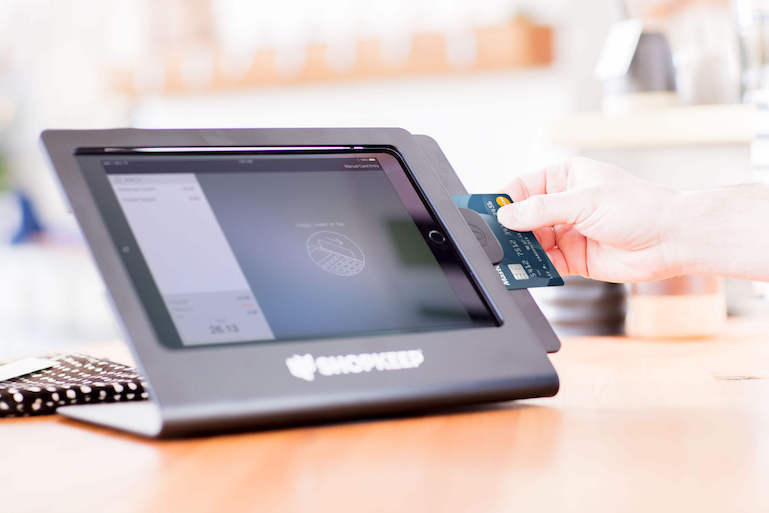
What is a Merchant Account? (The Need-to-Know)
One of the most significant decisions you need to make as a small business owner is what kind of payment methods you’ll accept.
Operating a cash-only business is likely the easiest way to get started, but with 7 out of 10 Americans owning a credit card, is it the best experience for your customers? Think about how many sales you’ll lose when shoppers walk into your store, cafe, or restaurant expecting to pay with their card, only to find out you’re a cash-only establishment.
As payment technology continues to advance and shoppers become more comfortable paying with their smartphones, you may also want to consider accepting mobile payment methods like Apple Pay and Google Pay. Gift cards are also a nice touch and can give you a real sales boost, especially around the holidays.
We understand that this decision might be a little much for you right now, especially if you’re still trying to open your doors. So at a minimum, we recommend that you set up your business in a way that allows you to accept credit card and debit card payments. It isn’t hard to get everything you need to do so; plus, your customers and bank account will thank you.
So how do you do that exactly? Well, one of the main things you’ll need to do is sign up for a merchant account.
What is a Merchant Account?
At its most basic level, a merchant account is an account that you set up with a credit card processor. In technical terms, this processor is called an acquiring bank or an acquirer. The merchant account acts as an intermediary between you, your standard business bank account, and the credit card networks or issuing bank, allowing you to accept credit and debit cards.
You can think of a merchant account as a storage area for the funds collected from sales made with credit cards and debit cards. It goes like this, a shopper purchases something from you with their credit or debit card, the processor authenticates the transaction and moves the funds from the customer’s account to your merchant account. After a waiting period, which can vary based on the policies of your processor, the funds are moved into your standard business bank account.
SEE ALSO: How to Accept Credit Card Payments — the Ultimate Guide
How to Get a Merchant Account?
It’s pretty straightforward to set up a merchant account, but that doesn’t mean it’s necessarily a quick process or a decision to take lightly. Because of the critical role that your credit card processor plays in your ability to accept electronic payments, it’s important to do your research and find the right processor for your needs.
Whether you start with a simple Google search, get a recommendation from you a fellow small business owner, or maybe speak to your local bank, you can do your research in the way that makes you most comfortable.
Before you get started, there’s one big thing that you’ll need to understand. There are many different entities where you can get a merchant account. For example, your local bank may offer this as a service, or you can work with a merchant service provider (MSP) or an independent sales organization (ISO). We strongly recommend that you work with an MSP or an ISO as they often offer additional merchant services like loans and merchant cash advances, which can give you a valuable injection of cash when you need it most.
Here are some additional criteria you’ll want to consider when looking at merchant account providers:
Reputation and Reviews
Don’t just rely on the information that a merchant account provider puts on their site or what a sales rep tells you on a call. Dig deeper and look for actual customer reviews from a service like Trustpilot or the Better Business Bureau. In particular, look for comments about the quality of customer service, the speed of payouts, and the handling of disputes or a chargeback.
Processing Rates
This is one of the significant areas of competition between merchant account providers, so be sure to shop around to find the option that offers the best rate for your particular business type, transaction volume, and average transaction size. A good rule of thumb is to look for a processor that charges you interchange rates (the basic rate set by credit card companies like American Express, Visa, and Mastercard) with a minimal per transaction fee layered on top.
Other Fees
You’ll need to read the fine print for this one, but many merchant account providers charge a variety of hidden or extraneous fees for some pretty common activities. Think about your business needs, and look for the account provider that isn’t going to nickel-and-dime you on every transaction.
Customer Service
At a minimum, you want to work with a provider that offers customer support during your business hours. That way, if you run into a problem during the middle of the day, you can start fixing it immediately versus waiting for the support to become available. Outside of hours, you’ll also want to look into how that support is delivered. Does the provider offer phone, chat, or email support? All of the above? Problems will happen so you want to be confident that you can get the support you need, in the way you want to receive it.
Contracts
Most of the time you’ll need to sign an agreement to work with a merchant account provider. This isn’t necessarily a bad thing. You’ll just want to make sure that the contract length is a term that you feel comfortable with. You should also consider whether or not there are cancellation or early termination fees should you become unhappy with their service and wish to get out of the arrangement.
Hardware Compatibility
If you’re looking to accept credit card or debit card payment, you’ll need more than a merchant account. You’ll also need also need the hardware to do so. For most merchants, this means a credit card reader and a point of sale (POS) or electronic cash register. The models you choose are up to you; however, you’ll want to ensure that they’re compatible with your merchant account. Otherwise you won’t be able to accept debit or credit card transactions.

What About Online Payments?
If you want to leap into ecommerce and selling online down the road, you’ll want to make sure that your merchant account can support online payments. You’ll also need to sign up for a payment gateway.
A payment gateway can best be thought of as a virtual POS or virtual cash register. It’s a technology that enables you to process transactions through your online store. When a customer enters their card details on your site, it’s the payment gateway that sends this information to your credit card processor and the customer’s card issuing bank. Once those services approve the transaction, this information is sent back to the payment gateway which allows your online store to finalize the sale.
Requirements For Signing Up For a Merchant Account
Once you decide on the merchant account provider you want to use for your business, you need to begin the actual sign up process. But before you do that, there are a few things you’ll need to know, specifically the requirements you’ll need to meet to sign up successfully.
The Underwriting Process
A bank, MSP, or ISO takes on some measure of risk when offering you a merchant account. In instances where a customer requests a refund, typically the account provider is on the hook for issuing money back to the customer before recouping their money from you. This process is called a chargeback.
Underwriting is a process where the account provider reviews your business details like your credit score, the age of your business, product offerings, etc. to determine the amount of risk associated with offering you an account. Reputable providers have this down to a science, and even if your business is deemed high-risk, don’t worry. Many merchant account providers work specifically with high-risk businesses.
PCI Compliance is Essential
PCI Compliance is a set of data security standards that mean your business operates in a way that enables you to process payments securely. You don’t necessarily need to be PCI Compliant to sign up for a merchant account; however, once you begin accepting electronic payments, you will need to be. Providers may look more favorably on your business during the underwriting process if they know your operation is set up to meet PCI Compliance once your account is in place.
You Need a Business Bank and License
If your business is already up and running, there’s a strong likelihood that you already have a business license and a business bank account already. However, if you’re still in the planning stage of opening a business, you likely don’t have these yet. In the vast majority of cases, both are requirements for getting a merchant account, so be sure you have them in place before you apply.
Wrapping it Up
There you have it, an overview of merchant account services, why they’re needed if you want to accept electronic payments, and some guidelines for picking the right one for your business. Interested in an all-in-solution that will cover your payment processing and point of sale needs? Check out ShopKeep Payments and ShopKeep POS to get started.
SEE ALSO: The 8-Minute Guide to Ecommerce vs. Traditional Commerce
Want to try ShopKeep for yourself?
Just answer a few easy questions.
Need help finding the right point of sale?
Just complete the form. We’ll call you right back to explain how ShopKeep can work for you.
Hit the ground running.Sprinting, in fact!
Read our free, comprehensive guide, Small Business 101, to learn all you need to know about starting a thriving business.

